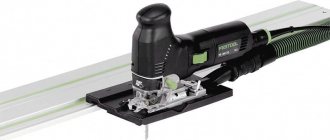A jigsaw is a hand-held tool with an electric drive. Designed for processing various materials. The main task of a jigsaw is to cut objects.
When a jigsaw operates, through a pendulum-return mechanism, the force from the engine is transferred to the cutting tool - the file. A jigsaw file processes (cuts) various materials: wood, metal, plastic, ceramics, cement, etc.
The most common are cutting tools for working with various types of wood and products made from it, soft metals and plastics, and products made of black and stainless steel.
Some features when choosing files
Pitch (t) is the distance between the tips of the teeth. In some countries, the pitch is designated TPI (teeth per inch). Measured by the number of teeth per inch (for example, TPI = 7, i.e. 7 teeth per inch). When cross-cutting wood, it is convenient to use a saw with a large tooth t = 3.5-6.5 mm (TPI = 7-3.5), for ordinary carpentry work - with a medium tooth t = 3-3.5 mm (TPI = 9 -7), for critical sawing - with a fine tooth t = 2-3 mm (TPI = 13-9). In this case, it is necessary to take into account the thickness of the material being cut.
It is easier to saw with a jigsaw when 5-8 saw teeth are used when cutting. If this rule is not followed, the blade will vibrate during operation, and the cutting line will turn out crooked and torn.
The stability of the saw blade when cutting in a straight line depends on the thickness of the file. For cutting thick workpieces, it is better to use circular saws.
DIY jigsaw guide
If a jigsaw cuts crookedly, and it is not advisable to buy an expensive guide, you can completely get by with improvised means. Any smooth edge with a thickness of 5 mm or more can become an impromptu stop: a straight strip, usually a piece of plywood and other straight surfaces of suitable sizes. A pair of ordinary clamps can serve as clamps for the guide to the material. If the condition of the surface of the opposite part of the material being sawn is not of great importance, the guide can be screwed onto a pair of self-tapping screws.
To make the fishing line as neat and even as possible, use the optimal file suitable for the material being processed. More visual processes for making and using a homemade guide are demonstrated in the following videos.
Wood saws
Wood saw blades are used for processing boards, plywood, fiberboard, particle board, laminate and other wood materials.
A characteristic design feature of these saws is enlarged cutting teeth and an increased distance between them. Typically: 2.5-4 mm. This can be determined visually by comparing cutting tools for jigsaws with different purposes.
Within their category, these files are also divided into several types:
Universal canvas
Designed for quick rough processing of wood up to 5 cm thick (for example, floorboards), metal, plastic. Dimensions: blade length 135 mm, tooth pitch 2.0-3.0 mm.
- in steel 5-10 mm,
- in soft metal up to 20 mm,
- in profiles 10-50 mm,
- in polymeric materials up to 30 mm,
- in aluminum up to 20 mm.
Saw blade for thick wood
Processing up to 110-130 mm. The geometry of the teeth is the same as that of the universal saw blade, however, the length of the working part is 155 mm. Using this saw you can cut timber with a thickness of 120-130 mm (HGS 54 / T744D)
File with reverse sharpening of teeth
Cut without chipping on the surface
It is used where a clean, chip-free cut on the surface is required;
Bimetal cutting blade
It consists of two alloys, the main (back) part is made of elastic steel, the working part consists of special high-quality high-speed steel. A big plus of this design is a significantly increased service life;
File for clean curved cuts
The blade, halved in width, allows for accurate curved cuts, for example, in a circle;
Blade for cutting floor coverings
Used for processing wooden products with a hard top surface (for example: laminated flooring).
Selection of cutting blade
Jigsaw blades vary in length and frequency of teeth. It is worth giving preference to trusted brands, in this case there is a quality guarantee for the metal, and the cut will be smooth. Files are classified by tooth configuration:
- on standard models, teeth of the same size are located at equal distances and in the same direction;
- the so-called skip-tooth file is distinguished by the absence of teeth, due to which the cutting speed increases, the blade heats up and jams less, and chips from the surface are removed to the side;
- In the case of double teeth, the cutting speed is lower, but the quality of the cut is better. The chips are removed from the cut;
- For reverse blades, some of the teeth are directed upward. Using such a tool, you can cut laminated chipboard and other wood with a jigsaw without chipping, since the upper teeth cut the material during the reverse movement.
The specific thickness of the blade depends on the material to be worked with, but the basic ones for the manual model are No. 3, No. 5, No. 7.
Files for working with metals and other materials
A distinctive design feature of the cutting tool, compared to wood saws, is the reduced distance between the teeth (1-2 mm), as well as the smaller size of the teeth themselves.
The main material is high-quality high-speed steel.
To process durable and hard materials, blades made of bimetal are used. The loaded working part is made of hardened steel. The main, rear part is made of durable and elastic high-carbon steel.
The cutting depth for metal rarely exceeds 2-3 millimeters. When processing metal of such thickness, you need to be careful, since the rigidity is low, there is a risk of warping (bending) of the product. To prevent this from happening, the part must be firmly secured. For such purposes, it is better to purchase or make a workbench yourself.
The rigidity of the file is affected by the thickness of the cutting blade. But chasing thick saw blades for cutting large cross-section materials is not advisable. It is better to use a circular saw. The purpose of the cutting tool is usually indicated on the packaging.
Explanation of markings
Files are made from various grades of steel, which influence the purpose of the blades and are indicated by logos:
- CV (HCS) is an elastic alloy alloy for cutting wood, synthetic and wood-composite products.
- HSS is a strong high speed steel for hard materials.
- BM (Bi-Metal) is a compound of the first two grades of steel that can withstand significant loads and is suitable for many operations.
- HM is a carbide for cutting tiles and building blocks.
Shank types
The most common files are with the following shanks:
T-shank
The name comes from the graphic resemblance to the letter T, another name is “cruciform”. Structurally, it has one stop. This type of shank is one of the most common. There is a variety with a double stop. Among the masters, another name is used - “European type”.
U-shaped
A straight shank with a semicircular notch at the end is called the “U-shaped” shank type. Used in conjunction with jigsaws manufactured according to USA standards. Hence another name - “American type”.
Manufacturers of jigsaw files
Today, the highest quality cutting tools for jigsaws are produced, for example, by Hitachi and Makita. Inexpensive ones, for example, are files under the Ermak brand.
Most of the canvases have alphanumeric symbols. One of them is the manufacturer's trademark. The rest contain information about the purpose of the files. It is better to learn more about this from the original source - on the manufacturer’s website.
Marking of files
The first letter is T or U. The type of saw attachment.
- The first number 1,2,3,7 is the working length of the file.
- 1 - short (up to 75mm)
- 2 - medium (75 - 90 mm)
- 3 - long (90-150 mm)
- 7 - very long (more than 150mm)
- The second and third numbers determine the purpose of the file.
- Subsequent letters:
- A,B,C,D - saw tooth size.
- F - bimetallic files. Such files have an increased service life, cut faster and with better quality.
- P - cut at a precise angle. Such files have a thick blade, so they cut the material strictly perpendicular to the surface.
- O - curved cut
- R - reverse tooth
- X - universal file for any materials
- HM - carbide file
This classification is arbitrary and is not always followed, so the most reliable way to choose a suitable file is to know its characteristics.
Review of Bosch files for curved cutting with a jigsaw
For example, the purpose of a file from the Bosch brand – “T101BR”:
Read also: Ss24 Schottky diode how to check
“T-shaped” shank, medium (second) file length, fine tooth, finishing reverse cut. The processed material is plywood, chipboard, fiberboard, laminate, laminated wood, plexiglass, plastic.
Video Jigsaw cuts crookedly or choosing a file
A jigsaw can cut any material – stone, metal, wood. The electric saw makes straight, miter and round cuts. How to learn to cut smoothly with a jigsaw?
Gentlemen, how to cut boards with a jigsaw so that the cut is good,
subzh, plus what you can cover the end with, if you have to.
saw along the guide! The file must be sharp and of high quality. It is not usually necessary to cover the end, it is not some kind of disgrace.
In general, I am engaged in the construction of websites and online stores.
Use a hand jigsaw to cut out. If your hands don’t hold well, then edge with a chipboard edge
Pekkonen wrote: saw along the guide! The file must be sharp and of high quality. It is not usually necessary to cover the end, it is not some kind of disgrace.
It is necessary to make a curly curved rounding (shelves), the radius of the circle is 100 mm. There is no crooked exact template. How to get out of this situation? The file must be sharp and of high quality - how do you understand this? Which file should I take? large, small tooth? Diluted or not (for metal)? What does quality mean? Which one produces less surface chipping?
If you are sawing the ends, it is better to use a metal file; it has a small tooth, so it does not tear.
T-34 wrote: The file must be sharp and of high quality - how is this to be understood?
Literally.
T-34 wrote: Which file should I take? large, small tooth?
The tooth size depends on the thickness of the board. And her hardness.
T-34 wrote: Which one produces smaller surface chips?
Pekkonen wrote: The file must be sharp and of high quality
I didn’t like Boshevsky Extra Clean. How I sawed curves on window sills (oak, 40 mm thick):
- First about the straight cut. Not a single file cuts straight, they all go slightly to the side. You need to move the jigsaw “diagonally” to where the file goes, and not forward.
- The guides don't work. Because of point 1 - the jigsaw does not cut straight forward, along the edge of the sole. If at the level of the sole the file can be forced to go straight, then from below it will go where it wants, the cut will not be vertical.
- We mark the line for sawing with a sharp knife. Roundings - according to a pattern, such as a pan, plate, flower pot, etc.
- When sawing, keep, say, the left part of the cut from 0 to 0.2 mm to the right of the marking line. Even if the file wants to tear out a sliver, it will break off along the marking line and everything will be beautiful. Remember to rotate the jigsaw when turning (around the file, not around some other point), and never push it sideways. The file is by no means a support for the jigsaw when turning.
- If you actively push the jigsaw forward, the file will “stick” and go sideways at the bottom of the cut. Therefore, we make almost no effort forward at all. We're pressing a little, there's no hurry - we have to be careful. Even a slight decrease in the speed of the jigsaw means that you have pinched something somewhere.
- Try sawing with different settings for the saw moving back and forth, choosing an effective and clean mode.
- A file of normal quality was enough for me to make 20 centimeters of cutting, after which I had to push it forward by force, and it no longer worked smoothly. But it was a thick oak.
- Take files that are very narrowed at the back, otherwise when turning the file will rub against the rear edge and go in the wrong place. The teeth are as fine as possible. The sharper the tooth, the faster the file will wear out, but the cut will be cleaner. I often used very narrow "circular" files.
plm wrote: I didn’t like Boshevsky Extra Clean. How I sawed curves on window sills (oak, 40 mm thick):
- First about the straight cut. Not a single file cuts straight, they all go slightly to the side. You need to move the jigsaw “diagonally” to where the file goes, and not forward.
- The guides don't work. Because of point 1 - the jigsaw does not cut straight forward, along the edge of the sole. If at the level of the sole the file can be forced to go straight, then from below it will go where it wants, the cut will not be vertical.
- We mark the line for sawing with a sharp knife. Roundings - according to a pattern, such as a pan, plate, flower pot, etc.
- When sawing, keep, say, the left part of the cut from 0 to 0.2 mm to the right of the marking line. Even if the file wants to tear out a sliver, it will break off along the marking line and everything will be beautiful. Remember to rotate the jigsaw when turning (around the file, not around some other point), and never push it sideways. The file is by no means a support for the jigsaw when turning.
- If you actively push the jigsaw forward, the file will “stick” and go sideways at the bottom of the cut. Therefore, we make almost no effort forward at all. We're pressing a little, there's no hurry - we have to be careful. Even a slight decrease in the speed of the jigsaw means that you have pinched something somewhere.
- Try sawing with different settings for the saw moving back and forth, choosing an effective and clean mode.
- A file of normal quality was enough for me to make 20 centimeters of cutting, after which I had to push it forward by force, and it no longer worked smoothly. But it was a thick oak.
- Take files that are very narrowed at the back, otherwise when turning the file will rub against the rear edge and go in the wrong place. The teeth are as fine as possible. The sharper the tooth, the faster the file will wear out, but the cut will be cleaner. I often used very narrow "circular" files.
Why does a jigsaw cut crookedly?
Initially, a jigsaw was intended for cutting out patterns and circles. The straight sawing function is not available on all models. The price of such a tool is many times higher.
You can achieve a straight cut with a regular jigsaw. To do this, you should use a ruler, which should come with the kit. To make it easier to control the sawing process, you need to reduce the speed.
Beginning craftsmen often encounter a problem: when cutting, the jigsaw moves to the side, and the cut is made at an angle. To cope with this, you need to study in detail the process of correct and even cutting.
There are several reasons for an uneven saw blade:
- the saw is dull;
- too much pressure is used;
- There is a cross grain in the wood.
One of the reasons for a crooked cut may be that the material is too thick. As a rule, thin wood is easier and easier to saw. The jigsaw may have poor mechanics - in this case it needs to be changed. You can check the quality of the jigsaw by moving it from side to side. If it's loose, it's a cheap tool for rough work. To get an acceptable result, you should cut with a margin, and decorate the edges with a hand router.
Another effective way to learn how to cut smoothly with a jigsaw is to draw not one line on the workpiece, but two parallel ones. This way the cut will be smoother.
Some people recommend using the pendulum function. There is no need to press on the jigsaw - it should move on its own. You can try changing modes.
Choosing the right tool
A few tips from experienced professionals will help you choose the right tool for the job.
For cutting at home, a household or semi-professional D-shaped jigsaw, which can be operated with one hand, is sufficient. The more power, the heavier the jigsaw, and to cut .
A step speed regulator, an electric stabilizer and a pendulum stroke will greatly facilitate the cutting process. The presence of a plastic pad on the sole will allow you to firmly secure the machine to the cutting blade. Useful features include integrated airflow and lighting.
It is worth paying attention to the fastening of the canvas. Some models have a restriction that does not allow the use of any file.
to cut boards with a jigsaw; there are circular saws and hacksaws for this. Although the most powerful tool can cope with the task, it is unlikely that it will be possible to achieve a completely even cut.
Straight cutting technique: nuances you need to know
To achieve an even cut, additional tools are used. Before you start sawing, you need to secure the material well. The work surface must be stable. Experts do not recommend sawing wood along the grain. It will be difficult to achieve an even cut. It is better to use a circular saw. If it is not there, you can use a rip fence. One edge is fixed on the product, the second leans against the tool. This way the cut is evened out.
If you need to make a circle, first drill a small hole in the middle. A jigsaw is attached to it, moving along the contours of the marked lines. When a rectangle is required, the saw is pointed forward, rounding the corners and then shaping them.
To make the move easier, use machine oil. They lubricate the file with it. To avoid overheating, you should stop occasionally. After sawing, you need to clean the jigsaw and moisten it with oil.
Fastening material
In order for the cutting line to be smooth, the working surface must be as stable, rigid and durable as possible. When working at home, this can be an ordinary table with reliable legs and a flat tabletop.
The board is fixed to the surface using clamps secured on both sides with moderate force. The sheet to be processed must be positioned in such a way that the tool does not rest against the surface during operation. To prevent pressure from being applied to the saw during the cutting process, you can weigh down the protruding edge hanging from the surface using an attached weight.
Rules for smooth sawing with a jigsaw
- For a perfectly smooth saw, it is necessary to use a device with an increased frequency of blade movement. It is better to choose a large file. A board will serve as a guide. Pre-prepare 2 clamps with a workpiece and a guide. To ensure that the jigsaw is positioned freely, it is placed on a raised platform. Using a tape measure, measure the width of the material, draw marks, and make one line out of them using a ruler.
- The guide is placed a few centimeters from the cut. It is attached with clamps. The jigsaw is placed with the cutting part against the cutting line. Connect it to the guide and attach it with a clamp. You need to make sure that she doesn't move.
- The same manipulations are performed on the other side. To ensure that there are no defects left on the wood, you need to clamp lightly.
- The next stage is moving to the first clamp, checking its stability and clamping. After this, turn on the jigsaw, setting the highest speed. The number 2 is set on the pendulum. The file is installed along the cutting line. The guide is pressed against the side of the platform and sawing begins.
- By controlling the position of the platform, the tool is moved forward. When there is just a little left to the end, you need to support what you sawed off so that it does not break off. The cut pieces will be perfectly straight.
- To make the saw glide smoothly and easily, some people use a removable blade. It comes from different materials. It is fixed on the support sole of the saw. The guide bar and adapter ensure an even cut.
- Some materials require additional cooling. When working with them, you need to keep a bowl of cool water near you. It can be installed on a support sole.
A jigsaw is a universal tool that is indispensable in the household. Knowledgeable people say: skill in handling it comes with experience. The more you train, the better the result will be.
In the arsenal of almost every home craftsman there is such an indispensable tool as a jigsaw. I am sure that every man encountered this tool during labor lessons during his school years. True, in my youth, a jigsaw was a hand tool and consisted of only three parts: a bracket on which the file was attached, the file itself and the handle. Only wood could cut such a tool. Currently, the manual jigsaw has become a thing of history and has been replaced by a powerful electric tool capable of performing a greater number of different operations. We’ll talk about how to choose a jigsaw in this article.
It's time to mechanize your work!
Of course, no one is going to give up a regular hacksaw for wood. However, an electric tool works much faster and allows you to save not only time, but also your own effort. And the quality of work in this case is much better. And so, standing in front of a store stand and choosing their very first power cutting tool for wood, many home-conscious owners ask themselves the same question: “What to buy first, a jigsaw or a circular saw? Where to start building your home work arsenal? The situation is quite understandable, because not everyone can afford both – the budget, you know, is limited. Which tool should you choose? “In fact, the answer to this question is very simple,” say the developers of the AtakaTM cutting tool, “you just need to proceed from the work that you perform most often at this stage. If, for example, you are just mastering carpentry or carpentry, then you definitely don’t need a high-performance circular saw that cuts a bunch of large lumber in one fell swoop - for starters, a jigsaw will be enough for you.” Yes, in terms of its production characteristics and quality of cutting, the circular saw for wood has long overtaken the jigsaw. It is more universal in use. It can cut almost any material with the exception of hard metals. Using it on a machine, you can make edged boards of a wide variety of sections and from a variety of wood species; you can cut large sheets of plywood, chipboard, fiberboard, plasterboard, plastic - yes, in general, any building materials, for example, for building a country house. The circular saw easily makes both transverse, longitudinal, and inclined cuts, and even double-sided ones, and very accurately and cleanly. But do not rush to draw conclusions and sing odes of praise to the circular saw for wood. For all its versatility and productivity, it still can’t do everything. There are types of woodwork that she cannot do; Moreover, for which it is absolutely not suitable. For example, she will not be able to cut a beam 100mm thick, because the limit of her capabilities is 75mm. And a circular saw for wood cannot make curved cuts and cut holes of different shapes in a not very thick wooden sheet, select a rectangular recess, cut laminate flooring cleanly and without stakes, and so on. But the jigsaw copes with all this, although slowly, but easily. Only a jigsaw can make figured cutting, only it can round the cutout of a flat carpentry part or cut a recess in a beam or beam or select grooves. In addition, the jigsaw is quite light in weight and not very noisy. And there are also models that have a chip suction system. That is, a jigsaw is safer from a labor safety point of view. Or, for example, during the most common cross-cutting of a board, when working with a jigsaw you can control the accuracy of the cut line to the very end, while when working with a circular saw on wood, due to its design, the cut line is not always visible to the end - sometimes you have to complete the operation blindly. The main thing is that the jigsaw blades are well sharpened, otherwise the squareness of the cut will be disrupted.
Source: newsvo.ru
Modern jigsaw
A modern jigsaw is equipped with built-in safety features, an electronic speed controller, and vibration and noise dampers. A special protection is installed above the base plate, which protects against accidental contact with the saw blade.
Using a screw or a special clamping device, the jigsaw file is rigidly attached to the spindle and makes translational movements up and down with high frequency. If the jigsaw is equipped with a multi-stage pendulum mechanism, then the saw blade can be tilted back. The pendulum mechanism increases the speed of straight cuts and extends the service life of the saw blade. Also, the jigsaw has a horizontal support platform, with which it rests on the part being cut. This significantly improves cutting accuracy. Usually the guide is made to rotate at an angle of up to 45 degrees.
Depending on the method of fastening the file, a jigsaw can be: with a cross-shaped shank, with a smooth shank and a shank with a hole.
Guide rail for jigsaw
The guide for a jigsaw is a simple device, at first glance, similar to a large metal ruler or rule. The main difference between the tire and the above devices is a special groove along which, like on rails, the sole with a jigsaw . Most guides have rubberized strips that prevent sliding on the surface of the material, and for additional fixation, they are attached with small clamps. The average length of such devices is from 1.5 to 3 meters, and can be increased by another, similar ruler, using an adapter.
How does a jigsaw work?
A jigsaw consists of a body with an electric motor, to which a saw blade is attached in a mounting hole at a right angle. There is a D-shaped or mushroom-shaped handle on top. A support sole is installed below, which slides over the workpiece, positioning the equipment. This design was invented in 1946 by Scintilla, a subsidiary of Bosch, and has remained in this form to this day. The controls include a power button and a blade speed control. In order not to constantly hold the start button, many models are designed to lock it. Markings are made on the workpiece along which the tool is guided. During operation, the saw blade moves up and down, which ensures sawing of the material. The cutting principle is similar to sawing with a hand jigsaw - the blade moves in the same way. Only when working with an electric tool, the user does not need to make reciprocating movements with his hand - he just holds the handle and guides the device along the cutting line. Models equipped with a pendulum mechanism allow, in addition to the speed, to select the positioning angle of the cutting tool. This allows you to select the optimal cutting mode for each material.
Read also: Formulas for serial and parallel connections
Sawing techniques depending on the material
Let us examine in more detail the main types of work performed with a manual jigsaw, depending on the type of material being cut. Also, each paragraph will provide its own nuances and features of working with a specific material.
How to cut a countertop for a sink at home with an electric jigsaw
The file and sawing speed are selected based on the material of the tabletop (chipboard, MDF, wood, etc.). The cut for round sinks is made using a compass, which can be included in the kit or made on your own. As an example, video:
There are jigsaws with grooves for a rip fence in the front of the platform. For them, you can make a compass from a metal strip, for example, a skewer.
Working with a complete compass
For square sinks with rounded corners, a marking-projection of the sink is applied to the material, and a cutout is made along it.
Working with plywood
Pendulum stroke (saw swing) is not used when cutting plywood. In the rocking mode, the edges of the cut are more torn and chips are formed. They start sawing at maximum speed. If the material begins to burn (turn black) due to strong friction, the speed is reduced to optimal by testing.
How to cut plywood without chipping
There are many ways to avoid chipping along the cut line, the most popular are: gluing the cut line with masking tape, using an anti-splinter sole, laying a second layer of plywood, etc. All of them have disadvantages - they require consumables, protect only one side, and are labor-intensive.
The most effective way is to select the right file.
The finest toothed metal saws, marked Metal, T118G, (tooth pitch 0.7 mm) practically do not tear plywood. Their disadvantage is that they cut slowly, yet they are not intended for plywood.
They combine well the speed and cleanliness of cutting with saws for wood and plywood marked Wood (wood) T101AO. HCS steel. The tooth is much larger than that of a metal file, so it cuts faster. It does not tear plywood either at the bottom or at the top, due to the straight arrangement of the teeth, not at an angle up or down, but strictly perpendicular to the blade (straight-tooth file).
What can be cut from plywood
Elements of any complexity can be cut from plywood - ornaments, trims, patterns, parts for machines, models, furniture, etc.
As an example, a photo of a figured element
Bent table legs and simpler curved parts are even easier to cut.
How to cut boards
You can also do this kind of work with a jigsaw if the cut area is small. But it is convenient for them to make short rectangular cuts in the board for a groove/tenon connection, a quarter, or “half a tree.” Also, a jigsaw is indispensable when you need to make a curved cut on a board, cut an oval or a large hole, etc.
A jigsaw is not suitable for long cuts along a board. It is better to spread the board onto the timber and trim the wane using stationary or, in extreme cases, manual circular saws.
The board is sawn using conventional methods. A saw blade for soft (Wood) or hard (Hard Wood) wood of suitable length is selected.
The most popular softwoods are: linden, alder, aspen, and all conifers.
Hardwoods: oak, beech, dry birch, ash, maple, pear.
How to cut chipboard and laminated chipboard without chipping
Sheet material is pulled out most of all from below. There, the file passes over the void, and the particles of material do not have the support and support they have at the top. To reduce chipping from below, sometimes a saw with a reverse inclination of teeth, with the tips pointing upward, is used. This type of file carries sawdust upward and tears out the underside less.
For your information! Straight tooth files are also used for a clean cut. For example, with the marking T101AOF made of bimetal (BIM). It can also cut hard wood, which is why it is labeled Hard Wood. If chips remain, select a blade with a finer tooth.
The photo below shows an example of cutting laminated chipboard.
In addition to the correct selection of files, other techniques are used:
- the laminate on laminated chipboard is pre-cut along the cut line with a mounting knife, in one or two strips along the thickness of the cut;
- stick masking tape along the cut line;
- An anti-splinter platform made of thin plastic is attached to the jigsaw platform.
It completely covers the workspace, leaving only a narrow strip for the file. When cutting, the platform puts pressure on the material and prevents particles from escaping from the mass. Protects only from chips on the top. It is more effective when using a file with a reverse inclination of the tooth (point up).
We also recommend reading an interesting article on how to properly cut laminate and other laminated materials with a jigsaw.
Is it possible to cut tiles and porcelain tiles with a hand jigsaw?
To cut these materials, another effective tool is most often used: tile cutters, cutting machines, angle grinders with special discs. But sometimes you need to cut a tile along a curved line, cut a semicircle, etc. A jigsaw of medium and high power with a special file (marked Special) is well suited for this. This file has a diamond coating and can cut ceramics and porcelain stoneware.
Plexiglas
These materials are sawed using the same methods and techniques as any sheet material. The most important thing is the correct selection of the file.
The difficulty is that under the general name “plexiglass” there can be a variety of materials - transparent acrylic, monolithic polycarbonate, various types of plastics and rigid polyethylenes, and even sheet mica for fireplace screens, etc.
They all have different ductility, flexibility, strength, density and are sawn differently.
For your information! As a base file, we can recommend the MPS3108 file. Although it is labeled Wood, the black color means it is versatile and can be used on a variety of materials. Canvas only on wood or on wood and metal of other colors. It has a medium step size and a reverse inclination of the tooth, with the tip pointing upward, so it pulls out less material from below.
An example of cutting polycarbonate in the photo below.
If the material is difficult to saw with this saw, continue selection according to the following principle:
- saws cleanly, but very slowly - select a blade with a larger tooth;
- the material tears along the cut, cracks - use a smaller tooth.
In this case, a tooth that is too small can heat the material to the point of plasticity and clog the file.
In any case, the blade for cutting plexiglass is selected using a real test cut , starting from the recommended base file MPS3108 or an equivalent.
How to cut at a 45 degree angle
Almost all jigsaws have the ability to adjust the position of the support platform.
For miter cuts:
- Release the platform by turning the locking lever or screw clamp (from the model).
- Rotate the platform relative to the file to the desired angle.
- Fix the platform.
Next, sawing is carried out in the usual way. It should be taken into account that when bevel sawing, the maximum thickness of the workpiece that can be sawed decreases. But the length itself was cut longer, because the saw cuts diagonally. Therefore, it is more difficult to saw the same board 30 mm thick diagonally than at a right angle.
DSP
CSP (cement particle board) consists of materials that are mutually exclusive from the use of saws. For shavings, you need a file for wood or chipboard, OSB, which will instantly grind off on cement. For cement, use a diamond-coated saw that cannot cut chips. Therefore, CBPBs are sawed with another tool with special discs.
It is recommended to use a jigsaw for cutting CBPB only as a last resort, for example, if you need to cut an oval with a small circumference. To do this, use the strongest metal files with small teeth. One blade can be enough for a 5-10 cm cut, sometimes more on thin sheets.
Slate
Slate is sawed using cutting machines and angle grinders with diamond blades. But they can't make a round neckline. Therefore, sometimes you can use a jigsaw with a diamond file for ceramics. For example, when you need to make a round cutout for a chimney.
Firewood
Firewood is cut with more powerful tools, chainsaws and circular saws. You can cut “wood” with a jigsaw. That is, cut and remove, for example, thin scraps so that they do not lie under your feet.
How to make a shallow cut
Using a jigsaw, you can make a shallow cut diagonally from the end of the workpiece. It will not be possible to make a long cut along the length, since the file must come out with the end down of the workpiece. Otherwise, it will hit the bottom of the cut and become clogged with sawdust.
Lining
The lining is sawed in the same way as any other wood, edged or unedged board.
Sometimes lining, due to the presence of a groove/tenon connection, like a wooden lining, is called fibreboard-based siding. It is sawn like fiberboard or laminate.
Working with metals
Metals are sawed using special fine-tooth files marked Metal. The tool is moved very smoothly and slowly. Sometimes lubricant is used. A jigsaw for metal is ineffective; there are other tools, but it is indispensable when you need to cut a small curved line.
We also recommend reading a detailed guide on working with metal with a jigsaw. The article contains everything you need, from choosing a file and jigsaw, to working techniques, depending on the metal.
Is it possible to cut drywall with a hand jigsaw?
Drywall is cut with a knife (in a straight line), a special hacksaw and a jigsaw - according to any line shape. GCR is a loose material.
For cutting, it is convenient to use the lightest jigsaws with a power of about 0.5 kW and a weight of 1.5-2 kg. Gypsum is an abrasive material. Despite its low density, it wears out teeth. Therefore, files made of high-strength steel with fine teeth, special for HA or for metal, are used.
Features of using a jigsaw
Despite the fact that the principle of operation of a jigsaw is quite simple, there are nuances that you need to know. They relate to cutting modes and materials. I will try to focus on the most common questions that arise for those who pick up a jigsaw for the first time.
What can you cut with a jigsaw?
A jigsaw is capable of working with materials of varying hardness, while effectively coping with their sawing. It is important to choose the right equipment and cutting modes. Saw blades differ in purpose : for cutting steel, aluminum and non-ferrous metals they are made of tool steel, for sawing wood - from chrome-vanadium or high-carbon steel, for plexiglass and ceramics - from harder materials, for example, an alloy of carbide and tungsten. There are universal files that are used for wood materials and plastic.
If there is a large amount of work to be done with a specific type of workpiece, for example, laminate, it is better to choose specialized equipment specifically for this task. The right choice is the key to quality work. It is worth noting that files are only suitable for working with homogeneous material. You cannot make a cut in a wooden workpiece with metal inclusions - nails or screws, as you can damage not only the equipment, but also the jigsaw itself.
Jigsaw cut thickness
For each tool, the maximum permissible values for the thickness of the workpieces to be cut are determined, and the rules for operating a jigsaw do not allow exceeding the recommendations specified by the manufacturer. For example, the parameters may be 75 mm for wood, 15 mm for metal.
What to choose: a jigsaw or a circular saw?
The volume and nature of the upcoming work will help you decide on the more preferable option. For example, if you are a beginner carpenter or the amount of work does not require much effort and a long time, then it will be enough to purchase a jigsaw. It can easily cope with cutting not only chipboard and plywood, but can also be used in sawing small boards.
For larger jobs, when you plan to cut for a long time and in large volumes, it is better to choose a circular saw. With its help you can cut sheet wood material, rather thick boards and bars.
How to install a saw blade in a jigsaw
There is a special seat for installing the blade in the spindle. If the file is secured with screws, then you must first loosen the fastening either with a key or a special lock, insert the file, and then securely fasten it. Most modern models use a self-clamping device for fixing the equipment. To do this, you need to lift the latch up, carefully insert the cutting blade into the vacated hole, and then return the latch to its original position. Only clean saw blades should be installed, with no chips or other foreign particles on the surface, otherwise the shank will not fit well. As the saw blade wears out, it must be replaced, otherwise the quality of the cut will deteriorate and the load on the tool’s motor will increase.
Rating of the best circular saws
We have compiled the top best circular saws based on user reviews and expert opinions.
Makita 5008MG, 1800 W
Cast sole, minimal play , disc immersion adjustment scale. Convenient adjustment locks, backlighting, and an additional disk included. Movable protective cover, start blocking. Connection pipe for vacuum cleaner, parallel stop.
power - 1800 W;
type of power supply - from the network;
cutting depth - 76 mm;
disc diameter - 210 mm;
rotation speed - 5200 rpm;
weight - 5.1 kg.
Prices in online stores
Interskol DP-190/1600M, 1600 W
Powerful, lightweight, clean cut without nicks . High-quality assembly, smooth start, long cable. Full functionality for an inexpensive model. Electronic engine protection, manual modification.
power - 1600 W;
type of power supply - from the network;
cutting depth - 65 mm;
disc diameter - 190 mm;
rotation speed - 4800 rpm;
weight - 5.5 kg.
Prices in online stores
ZUBR PD-65, 1600 W
Domestic electric circular saw. Lightweight and easy to operate , assembly without backlash or runout. Spindle lock, it is possible to connect a vacuum cleaner. Saw blade, guide, wrench, instruction manual.
power - 1600 W;
type of power supply - from the network;
cutting depth - 65 mm;
disc diameter - 190 mm;
rotation speed - 4700 rpm;
weight - 4.2 kg.
Prices in online stores
Makita HS7601K, 1200 W
Comfortable, ergonomic, powerful. No vibration, precise cutting , there is a storage case. Parallel stop, vacuum cleaner connection, hex key. Additional disk, motor brake, spindle lock.
power - 1200 W;
type of power supply - from the network;
cutting depth - 66 mm;
disc diameter - 190 mm;
rotation speed - 5200 rpm;
weight - 4 kg.
Prices in online stores
BOSCH PKS 55, 1200 W
Lightweight, moderately powerful - the best option for home use. Rubberized handles , high-quality plastic, no backlash or gaps. Saw blade, rip fence, dust container, vacuum cleaner adapter.
power - 1200 W;
type of power supply - from the network;
cutting depth - 55 mm;
disc diameter - 160 mm;
rotation speed - 5600 rpm;
weight - 3.9 kg.
Prices in online stores
What cuts can be made with a jigsaw?
Straight cut
The basic function when using an electric jigsaw is straight cutting. Short workpieces are quite easy to handle. It is much more difficult to guide the tool smoothly along a long straight line. In this case, the best option would be a wide saw blade, which helps to adhere to the intended trajectory.
Figured cut
For figured cutting, special equipment is used, which is marked with the letter “O”. These are files with a narrow blade and fine teeth, which provide a neat cut and do not pinch when turning. When cutting shapes, set the minimum speed of the nozzle. If it is necessary to cut at an angle, the position of the body is adjusted relative to the sole using a special fastener. In some models this is done with a key, in others with a lock.
DIY jigsaw guide
If a jigsaw cuts crookedly, and you don’t purposefully take an expensive guide, you can completely get by with the means at hand. An impromptu stop can be any flat edge, no matter how wide, 5 mm wide: a flat lath, usually a piece of plywood and other straight surfaces of suitable sizes. A pair of ordinary clamps can serve as clamps for the guide to the material. If the condition of the surface of the back of the material being cut is not of great importance, the guide can be screwed on with a couple of screws.
READ How to Cut Skirting Boards Using a Miter Box
We cut an apple tree with a jigsaw. GST 18 V LI & T1044DP.
To ensure that the fishing line comes out very neat and even, use the best file suitable for the material being processed. More enjoyable processes for producing and using a homemade guide are demonstrated in subsequent videos.
A jigsaw is a necessary tool that can be used to solve a huge number of household problems. The main thing is to use the necessary consumables suitable for each specific option and choose its operating modes well. Then, in the head of the novice master, the children's rhyme transforms into a call to action: “I will cut! I will cut! Will…".
How to use a jigsaw
Jigsaw blade speed
Most modern models provide adjustment of the stroke frequency of the equipment. For different models, the adjustment range can range from 500 – 800 to 2800 – 3000 strokes/min. They cut wood, plywood, steel, and aluminum at high speeds. Low speed is needed for plastic and stainless steel. Adjustment is also necessary when choosing the type of cut: fast straight cuts are carried out at high speed, figured cuts and finishing of edges require accuracy, which means the speed of movement of the equipment should be low.
How to achieve maximum efficiency when working with a jigsaw
When guiding the tool along the cut, you do not need to put much pressure on it. Excessive force can lead to deterioration in the quality of the cut and breakage of the file.
When working with a jigsaw, it is recommended to move the jigsaw along the drawn line, and not directly along it. This way, the line is better visible and the cut is made smoother. In addition, you do not have to include a tolerance for the width of the cut into the size of the workpiece.
When processing decorative materials, the workpiece is placed face down. This way, scratches will not appear on its surface.
To reduce the amount of sawdust in the processing area, use the blowing function or connect a vacuum cleaner to a special pipe. The less cutting waste on the workpiece, the better the markings are visible, and the easier it is for the file to make cuts.
Do not overload the tool. If there is a lot of work, let the engine cool down periodically so that it does not overheat. This is especially important when working at low speeds, when the fan does not have time to cool the jigsaw mechanisms.
Cutting technology
They begin sawing after securing the workpiece and applying markings. To do this, you need to turn on the jigsaw, set the maximum speed level and adjust the pendulum stroke by setting it to number 1.
You need to bring the file to the marking line, press the side of the platform against the guide and start working. When moving the jigsaw forward, you need to monitor the location of the platform. Do not deviate from the guide. When there are a few centimeters left to the end of the canvas, you need to carefully hold the free edge, avoiding breaking. At this point the process can be considered complete. To prevent the cut from turning out crooked, it is worth remembering a number of nuances:
- During operation, do not press too hard on the electric jigsaw, otherwise the file will break;
- when cutting a steel sheet, you need to choose a tool with maximum power and work at high speed - when heated, the steel softens and becomes more pliable;
- When processing plastic, laminate, organic glass or stainless steel, it is necessary to provide additional cooling for the file and periodically take breaks so that the tool has time to cool down;
- to prevent the plastic from melting during processing, it is necessary to set the minimum speed with a frequency of 1000 rpm;
- the figured cut will be smooth if you choose a narrow file with small teeth;
- After finishing the work, the electrical device should be cleaned of sawdust and placed in a special case.
Professional builders advise adhering to certain rules to help avoid mistakes that will not be easy to correct.
When choosing a file, you need to start from the material you are working with: plastic, thin or thick metal, plywood, solid wood. You should prepare in advance all additional items that may be needed during the cutting, marking and fastening process. Particular attention should be paid to fixing the material to the surface.
Note! To avoid defects, the canvas should be positioned face down.
It is best to try the sawing technique in advance and practice cutting with a jigsaw on unnecessary workpieces, because a crooked line will be difficult to correct. Safety precautions should not be neglected; you should use safety glasses and wear gloves when sawing.
If these recommendations are followed, the process of cutting parts should not be accompanied by unforeseen difficulties.
Safety precautions when working with a jigsaw
A jigsaw is a dangerous tool, so when working with it you must follow the safety rules:
- Take care of protective equipment. A respirator will prevent tiny dust particles from entering your respiratory tract, and glasses will protect your eyes. Wear gloves to operate saw equipment safely. So, you will not cut yourself with the sharp edge of the file and will not burn your hands when touching a metal sheet that is hot from high speeds.
- Secure the workpiece to the workbench using a vice or clamps. This will prevent it from moving during sawing and reduce the risk of the file jumping off.
- The part that you will saw off must be suspended. It is important to make sure that the file will move freely and will not touch anything. When turning on the jigsaw, the equipment should also not touch any surfaces.
- Take care of your hands while using the jigsaw. Keep them away from moving tools. After turning off the jigsaw, wait until the mechanism stops completely.
- Clean and maintain the jigsaw only when the power is turned off.
Types of electric jigsaws
Manufacturers of power tools offer consumers a huge range of different functions. Since both home craftsmen and professionals need jigsaws, they are divided into professional and household. There are also industrial models among them.
Household jigsaw
Household jigsaws are the cheapest. A household jigsaw has a limited resource and is only suitable if you do not plan to use it every day for a long time. Household jigsaws include the “Skil 4300 AG” model, which comes with a set of 6 files. This German company has proven itself well all over the world. In addition, Skil jigsaws have inexpensive prices among imported tools.
Jigsaws deserve due attention, for example, Makita 4324. It is more expensive than the previous model, but has a 4-stage pendulum movement of the saw. This feature of the tool provides a significant advantage when working with wood materials. The body of household jigsaws is usually made of plastic.
Read also: Nulevka skin, what is the number?
Professional jigsaw
A professional jigsaw will work uninterruptedly every day for 8 hours. When purchasing it, you need to think about savings secondarily, the main thing is performance and reliability. Such tools include “Metabo STEB 135 plus”. But for large-scale work, it is better to purchase a more powerful model. In addition to power, a professional will pay attention to the thickness of the material that an electric jigsaw can cut through. Metabo STEB 135 plus is guaranteed to cut wood material up to 135 mm thick. Pay attention to the comfortable handle for gripping the entire brush and the system for removing chips from the cutting zone, which has good performance. In professional jigsaws, the gearbox is placed in a metal case, which allows it to be well cooled.
Industrial jigsaw
Industrial jigsaws are designed to work around the clock. In practice, this is already a machine for straight and curved cutting of blanks from boards and sheet materials. This tool is suitable for use in small woodworking enterprises.
Reasons for chipping
If you observe the process of chipping, you will be able to find a pattern - when you make a cut from below, the teeth of the saw do not finish the material and chips do not occur when leaving the material.
If the process occurs from the bottom up, then the teeth cling and a fracture results. In the wooden material, fibers that are located nearby begin to cling, and if you cut the laminated chipboard, splinters appear and the coating deteriorates. If you try to saw two layers of laminated chipboard at the same time, the layer located below will be sawed very well, because the layer located on top will resist the appearance of chips.
Please note that the increase in processing accuracy is helped by the “soft start” option, in which the electric jigsaw gradually begins to pick up speed, and the cutting itself will occur as it should. The tool will advance slowly, and you should continuously visually monitor the position of the cutting point, as well as the marking.
How to choose a jigsaw
First of all, you need to decide for what purpose you are purchasing a jigsaw. You will be sawing laminate or chipboard when replacing floor coverings in the apartment, or you will have more large-scale work on making furniture yourself. Will it be periodic use or daily use with heavy loads? If you already have a clear idea, you can start choosing a jigsaw.
Type of power supply and design features of jigsaws
If cutting workpieces will be an auxiliary process, you will have to work in places where there is no electricity, you need a mobile tool and nothing should limit your movement with it, then a battery model is suitable for you - an excellent option for your home, cottage, or garage. But for long-term work, when working with a jigsaw will take up most of the process, it is better to use an electric jigsaw. Its operating time is not limited by the battery charge, like a cordless jigsaw, and you can work all day long. That is why the electric jigsaw is used in workshops and production. It is worth noting that batteries sooner or later fail. I wrote about how to restore a battery in a previous article.
If we talk about the ease of use of a jigsaw, it largely depends on the design of the tool. First of all, pay attention to the handle. It comes in two types:
- The bracket-shaped jigsaw handle is the most universal, suitable for straight cutting when the jigsaw is located on top of the workpiece;
- The mushroom-shaped handle of the jigsaw noticeably reduces the design of the tool, which makes it easier to guide when working from the underside of a part and sawing at an angle.
- Of the design features, the following functions will also be important:.
- Sawing parts at an angle is ensured by adjusting the sole of the jigsaw. For example, it can be tilted in such a way as to make a cut at an angle from 45 to 90°.
- The presence of a pipe for removing chips is useful if you want to use the tool in conjunction with a dust collector or vacuum cleaner. Through the dust removal system, sawdust will be removed from the working area, which will make the cutting process cleaner and safer, and will help save time on cleaning.
- Keyless replacement of equipment is convenient because no additional equipment is required to remove and install the saw.
- Fixation is carried out with a self-clamping device.
Laminate cutter
Another tool designed for cutting laminate flooring is a cutter that works on the principle of a guillotine. In other words, it is a sharp knife that, with the help of a handle, is lowered onto the board and smoothly cuts it. To work with the cutter, no skills or force are required; the cut is very high quality, smooth, without chips, and the process itself proceeds without noise or dust.
With the help of a cutter you can easily achieve a perfect, professional-quality result. But it is advisable to use this tool specifically for professionals, since it has a narrow specialization and is intended only for cutting laminate. Therefore, to repair two or three rooms, it makes no sense to purchase this tool.
Another disadvantage is that it is impossible to cut the laminate panel along the canvas, but only across it.
Many people, starting to renovate their apartment with their own hands, simply do not know how to cut laminate flooring. As it turned out, the most convenient and easy-to-use tool is an electric jigsaw.
If you follow certain rules, you can quickly learn and achieve good results. Each of the tools discussed above has some advantages over the others - the choice must be made in accordance with professional skills.
Technical characteristics of jigsaws
Like other power tools, jigsaws vary in a number of ways. Performance characteristics determine what loads the model is designed for, what workpieces can be processed, and how productive it is.
Jigsaw power
The power of a jigsaw is the main parameter that determines the class of the tool. Household jigsaws, as a rule, include models with a power from 300 to 500 W, and professional ones - up to 900 W or more. The more powerful the electric motor, the more productive the tool. Productivity means maximum cutting depth, cutting speed, and continuous operation time. It is worth remembering that the more powerful the power tool, the more it weighs, the greater the load on the operator’s hand. Therefore, when choosing the power of a power tool, a reasonable balance is needed.
Jigsaw speed
The cutting speed depends on this characteristic - the larger its range, the more materials you can cut. High speed is suitable for soft wood, medium for dense wood materials, plastic and soft metals such as aluminum, low speed for steel. If you are choosing a jigsaw to work only with wood, a model with a maximum strokes per minute of up to 2500 is sufficient. For working with plastic and steel, it is better to choose a model with a number of strokes over 3000 per minute. The most versatile jigsaws are those that operate in a wide speed range from 0 to 3100 strokes/min.
Jigsaw cutting depth
This indicator determines what thickness of workpieces can be worked with with a jigsaw. Low-power household models are capable of processing wooden parts up to 70 mm thick, and steel parts up to 4 mm. Professional jigsaws have a longer saw stroke, so they are capable of cutting wood with a thickness of over 100 mm, aluminum sheets up to 20 mm thick, and steel up to 10 mm.
Of course, manufacturers indicate more characteristics, since their task is to provide the buyer with comprehensive information about the weight, dimensions and other consumer properties of the tool. But these three parameters are the main ones when choosing. Using them, you can determine the purpose of a particular jigsaw model and decide whether it is suitable for the specifics of your work.
How to cut metal
A special metal file must be used. Its feature is small teeth.
With narrow or soft metal (aluminum, copper, etc.) you can set the engine speed higher. For better gliding and reducing friction forces in the cut, it is better to add a few drops of oil from time to time.
When cutting sheet metal, to obtain an even cut, it is better to slip a narrow plywood backing under it. Cutting will become much more convenient, since the sheet of metal will not vibrate much.
To confidently cut iron parts, the power of the jigsaw should be as high as possible. A good value for cutting metal is a value above 750 W.











